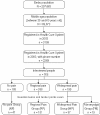Prevalence of fibromyalgia in a low socioeconomic status population
- PMID: 19505321
- PMCID: PMC2706216
- DOI: 10.1186/1471-2474-10-64
Prevalence of fibromyalgia in a low socioeconomic status population
Abstract
Background: The aim of this study was to estimate the prevalence of fibromyalgia, as well as to assess the major symptoms of this syndrome in an adult, low socioeconomic status population assisted by the primary health care system in a city in Brazil.
Methods: We cross-sectionally sampled individuals assisted by the public primary health care system (n = 768, 35-60 years old). Participants were interviewed by phone and screened about pain. They were then invited to be clinically assessed (304 accepted). Pain was estimated using a Visual Analogue Scale (VAS). Fibromyalgia was assessed using the Fibromyalgia Impact Questionnaire (FIQ), as well as screening for tender points using dolorimetry. Statistical analyses included Bayesian Statistics and the Kruskal-Wallis Anova test (significance level = 5%).
Results: From the phone-interview screening, we divided participants (n = 768) in three groups: No Pain (NP) (n = 185); Regional Pain (RP) (n = 388) and Widespread Pain (WP) (n = 106). Among those participating in the clinical assessments, (304 subjects), the prevalence of fibromyalgia was 4.4% (95% confidence interval [2.6%; 6.3%]). Symptoms of pain (VAS and FIQ), feeling well, job ability, fatigue, morning tiredness, stiffness, anxiety and depression were statically different among the groups. In multivariate analyses we found that individuals with FM and WP had significantly higher impairment than those with RP and NP. FM and WP were similarly disabling. Similarly, RP was no significantly different than NP.
Conclusion: Fibromyalgia is prevalent in the low socioeconomic status population assisted by the public primary health care system. Prevalence was similar to other studies (4.4%) in a more diverse socioeconomic population. Individuals with FM and WP have significant impact in their well being.
Figures
References
-
- Haq AS, Darmawan J, Islam MN, Uddin MZ, Das BB, Rahman F, Chowdhury MA, Alam MN, Mahmud TA, Chowdhury MR, Tahir M. Prevalence of rheumatic diseases and associated outcomes in rural and urban communities in Bangladesh: a COPCORD study. J Rheumatol. 2005;32:348–53. - PubMed
-
- Wolfe F, Cathey MA. Prevalence of primary and secondary fibrositis. J Rheumatol. 1983;10:965–8. - PubMed
-
- Senna ER, De Barros AL, Silva EO, Costa IF, Pereira LV, Ciconelli RM, Ferraz MB. Prevelence of rheumatic diseases in Brazil: a study using the COPCORD approach. J Rheumatol. 2004;31:594–7. - PubMed
-
- Cardiel MH, Rojas-Serrano J. Community based study to estimate prevalence, burden of illness and help seeking behavior in rheumatic diseases in Mexico City. A COPCORD study. Clin Exp Rheumatol. 2002;20:617–24. - PubMed
Publication types
MeSH terms
LinkOut - more resources
Full Text Sources
Medical
Miscellaneous


